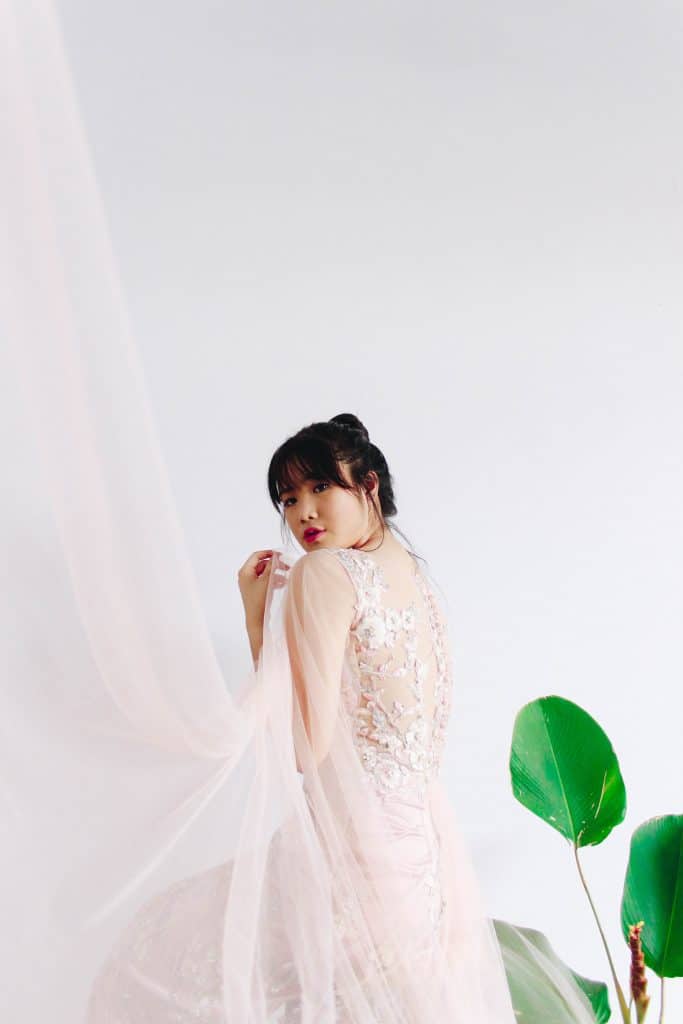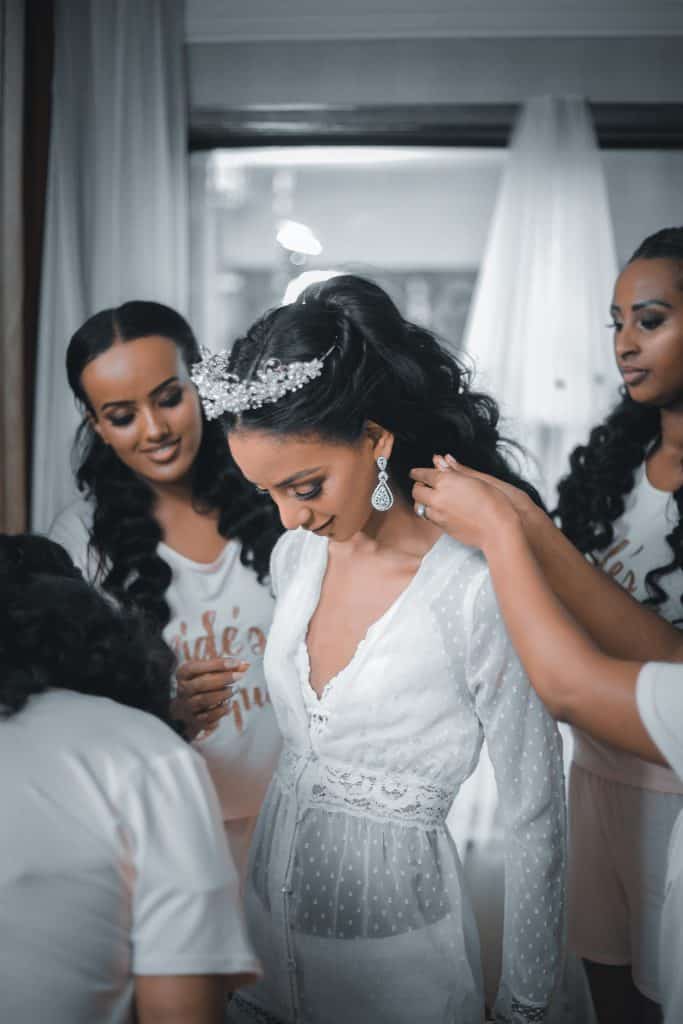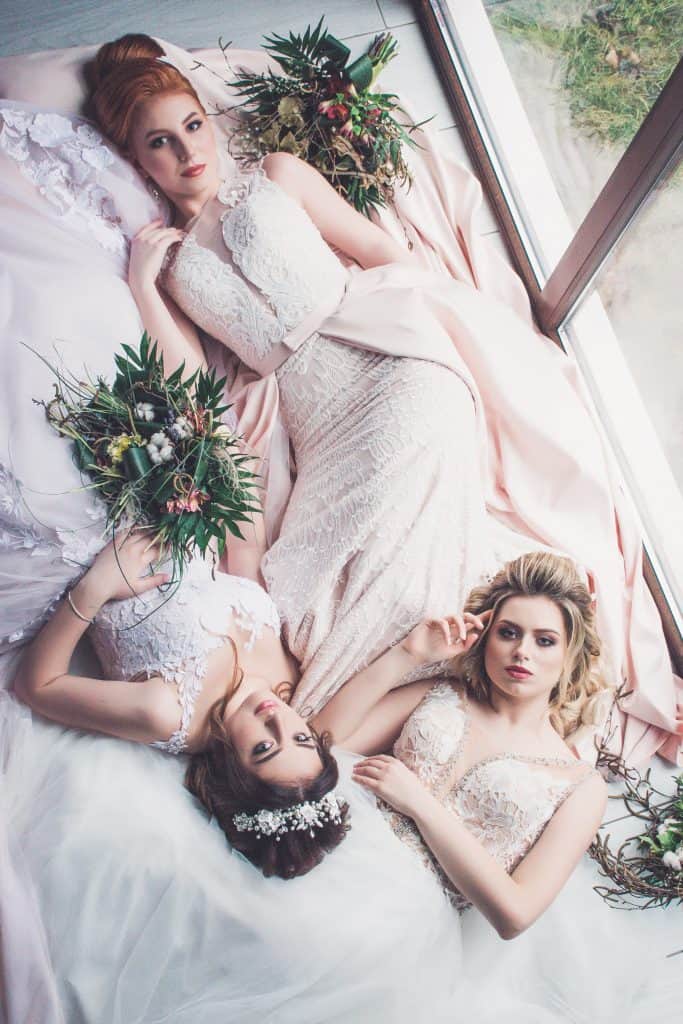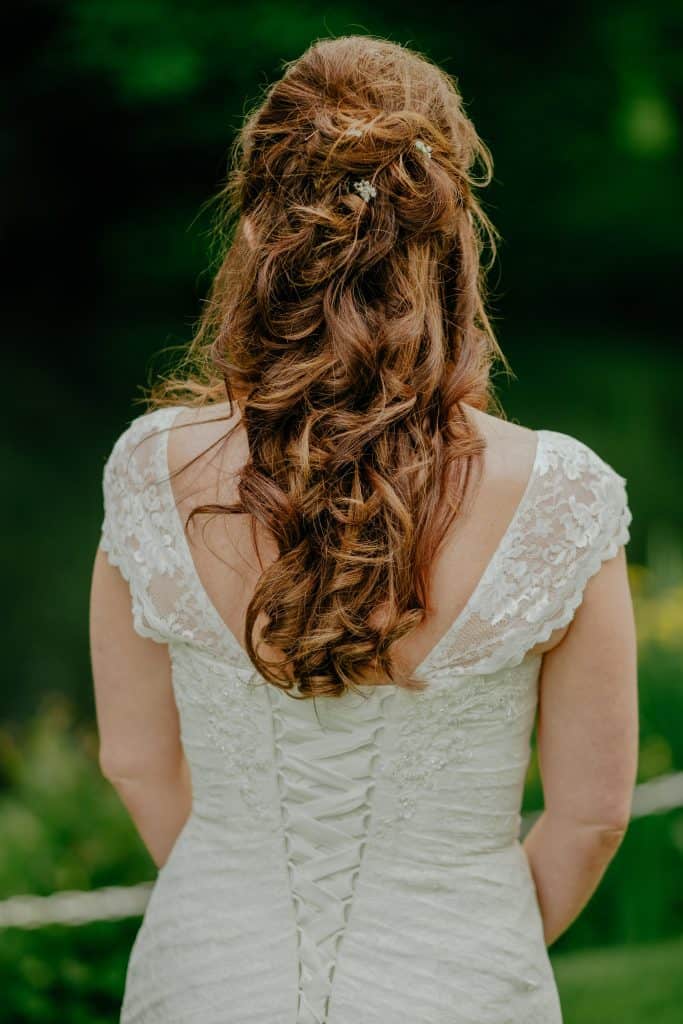
Many brides and grooms are shocked by the cost of alterations for their wedding dress and suits. If you don’t know how much to budget for your wedding dress alterations or that you even needed to tailor your suit, keep reading. I talked to real brides to get an average of how much you should expect to pay for alterations and some experts in tailoring for tips on how to keep costs down.
Wedding dress alterations are an unexpected expense for many brides. You should plan on paying 25% of your dress cost to have it altered. This is based on the average cost of $2000 for a wedding dress and $500 for alterations.
That means to appropriately budget for your wedding gown, you should reserve a quarter of your budget for alterations. So if you only want to spend $1,000 on your dress, you should find a dress that’s $750 and keep $250 in reserve for common alterations.
Keep reading for other things to expect when it comes to alterations like what types of alterations are possible and how far in advance you should plan for tailoring your dress.
What is the average cost of wedding dress alterations?
We asked real brides what they paid for their alterations and put together an average based on over 100 responses.
For wedding dress alterations, brides pay $500 on average. That price typically includes adding a bustle, hemming the bottom, adjusting the straps, and adding cups inside the dress. If you have intricate beading, lace, or need more complicated alterations you can expect to pay $1000 or more.
Most brides were in the $200-$1000 range when it came to alterations. Many of them needed the same items altered – shortening the hem, adding a bustle, adjusting the straps to make them shorter or remove them, and adding cups inside the dress to eliminate the need to wear a bra.
How much brides pay for alterations:
| How Much Brides Paid for Wedding Alterations | How Many Respondents Paid Each Price Range |
| Paid Less Than $200 | 24 |
| Paid $200-$500 | 34 |
| Paid $500-$1000 | 34 |
| Paid More Than $1000 | 11 |
As you can see from the chart above, 10% of brides paid over $1000 for alterations! These brides typically had more advanced alterations done. Things like getting the dress taken in, specialty services like a “booty hug,” complicated bustles, lace or beading work redone, or other significant changes.
The brides who paid less than $200 were able to do so because their bridal shop included alterations in the price of their dress. Or because they took the dress to a local tailor or friend instead of using the bridal salon seamstress.

Why do wedding dresses need alterations?
After seeing how much it costs, you may be wondering why do many brides need alterations in the first place. If you’re shorter than average, you may have gotten the occasional pair of jeans hemmed. But most people are not used to getting their clothes tailored and wear a certain size as it fits.
Wedding dresses need alterations because they are made to fit each bride and are often ordered in a larger size and tailored down to ensure the perfect fit. It is a special day and an expensive dress so most brides want it to fit perfectly.
Can you get away without alterations? Absolutely! You can order a dress from custom measurements that will be a closer fit than something off the rack. Or you can find a dress in your size that fits well enough you don’t think it needs to be altered.
How far in advance should you get your wedding dress altered?
We talked to an expert in bridal design and alterations, Desireé Singletary, for her advice on when to plan to get your dress altered. Her advice was to plan a few months for alterations depending on what you need done.
Brides should plan to get their wedding dress altered 2-4 months before the wedding date according to bridal alterations experts. That leaves enough time for common alterations such as a adjusting a hem or adding a bustle or more customization.
3-4 months if you have customization that needs to be done. Or 2 months for standard alterations (hem, bustle, taking in/out)
Desireé Singletary, Desiree Marie Design
A couple of months is enough time to find a tailor who specializes in bridal but it’s also close enough to your wedding date that you’re not likely to change sizes dramatically.
Looking for other key milestones like when to buy a dress? We’ve got you covered with this guide to how many dresses you’ll likely need to try on and how buying off-the-rack can save you time and money.

Is it easier to take in or let out a wedding dress?
It is easier to take in a dress than let it out. This is because of the fabric allowance of the dress. To make a dress size larger, you have add fabric somewhere. To take a dress in, you only have to remove fabric.
While it is more challenging to alter a wedding gown that is too small, it’s not impossible. Keep reading for what to do if you find yourself with a dress that is too small.
How many sizes down can a wedding dress be altered?
Generally, you don’t want to alter a wedding dress down more than two sizes. Further alterations will compromise the design and shape of the original dress.
If you do have to alter your dress more than two sizes, you’re not out of luck. For example if your heart’s set on wearing your mother or grandmother’s dress or an incredible off-the-rack find but it’s several sizes too big, you may be able to find a tailer who can help.
I have seen almost the impossible with a gown being taken in over 10 sizes. This is not ideal. Ideally the gown would only be taken down 2″ to not jeopardize the design/original shape of the wedding dress.
Desireé Singletary, Desiree Marie Design
If you’re planning to alter your wedding dress by more than 2″ make sure you’re taking it to a bridal specialist, not a general tailor. And try to leave more time for alterations.
What do I do if my wedding dress is too small?
If your dress is too small, don’t despair. There are some things that can be done to increase the dress size one or two sizes up.
If your wedding dress is too small, take it do a tailor who specializes in bridal. They can let it out, add fabric to the sides, or add a corset back. All of these adjustments can lead to a size increase of a few inches to up to 8″ or more.
Lots of options are available for a wedding dress that is too small. It can be let out possibly where it needs to be. Panels could be added to the side seams. This is a popular choice right now because sheer panels are on-trend. Another popular option in making a dress fit that is too small is removing the zipper and adding a corset in the back. This can add up to 8″.
Desireé Singletary, Desiree Marie Design
The corset not only adds inches but makes the sizing a little bit more flexible if you gain or lose any more weight before the wedding. The corset can be adjusted on the day to fit depending on how loosely or tightly it is tied. Here’s a dress that has a corset added to the back:

If you’re a plus-size bride, check out our guide to finding the perfect plus-sized wedding dress with advice from brides who’ve been there and found a great gown to wear down the aisle.
How do you not trip over a long dress?
If you have a long train or plan on changing from heels to flats for your wedding, you may be nervous about tripping over your dress. There are some things you can do to make it safer for you to dance the night away.
To minimize the danger of tripping in your wedding dress, you should have it hemmed in the shoes you plan on wearing to your ceremony or reception so it is the correct height. You should also add a bustle in the back that lifts up the train after the ceremony. Or you can add a wrist loop so you can hold up your dress.
Most wedding dresses need a hem and a bustle, and they especially need one if the bride is in danger of tripping over her dress. A bustle pulls up the train with hooks, or ribbons.
Desireé Singletary, Desiree Marie Design
Personally, I had a bustle on my wedding dress but it wasn’t quite high enough. Guests kept tripping over my dress and a button or two from my bustle may have ended up on the dance floor. I didn’t consider the fact that I would be dancing in flip flops instead of my white heels. And I only had one round of alterations because I bought my dress out of state. Most brides will have multiple rounds of alterations to ensure the right fit.
Definitely bring the shoes you plan on wearing on your wedding day, and any planned changes in attire, to your alterations appointments. That way your dress can be tailored with the exact height in mind.
Speaking of bustles…
What is a bustle?
A bustle is a sewing technique that allows you to lift the train or back of your dress off the floor and attach it higher up on the dress. It is commonly achieved with hooks, ribbons or buttons. This allows a dress with a long train to be showcased at the ceremony and then taken up for the reception.
There are a few advantages to having a bustle added to your gown. It makes it less likely for the bride to trip over her own dress. Makes is harder for guests to step on or trip over the dress. Makes it easier for the bride to dance and move around. And it ensures the dress doesn’t drag on the floor and get extremely dirty or damaged.
Can you alter sleeves on a wedding dress?
Whether you’re looking to add sleeves onto a dress, remove existing sleeves, or change the size and shape of them, you have plenty of options to change the sleeves of a wedding gown.
The bridal design and alterations expert we talked to for this article has a lot of experience in wedding gown alterations and said sleeve alterations were absolutely a possibility.
Absolutely. They can be taken in/out, shortened, and more. Adding custom sleeves to a wedding dress is also possible.
Desireé Singletary, Desiree Marie Design
Now let’s move on to suits.
Suits aren’t just for the boys. We’ve got a guide to men’s suits for women if you would prefer not to wear a dress. And a list of wedding dress alternatives for something other than white and poufy.

We got the scoop from Brandon Hosley, Designer & Style Engineer at Look Sharp Haberdashery.
As a men’s clothing designer and tailor, I want to ensure that the client feels comfortable and looks their best when getting dressed for their big day. Looking good and feeling good makes it all the more enjoyable. Getting dressed for a wedding should be an experience and not a dreaded task. It’s imperative to start early so that there is one less thing to worry about. We try our best to make it easy for our grooms and groomsmen to get to the altar in style.
Brandon Hosley, Look Sharp Haberdashery
When should wedding suits be altered?
Compared to gowns, suits take a lot less time for alterations. You should plan one to two months before the big day to get any adjustments made to a suit. This timing applies whether it’s for the groom, groomsmen, or a bridal suit.
Depending on the complexity of alterations needed, a groom can expect anywhere from 1 to 3 weeks turnaround on alterations, alone. From my experience, I would recommend having all wardrobe fittings and any adjustments made at a minimum of one (1) month before the big day. Anything inside of that one month time-frame is risking the guarantee of a smooth process and can increase pricing for the services rendered.
Brandon Hosley, Look Sharp Haberdashery
Is it expensive to tailor a suit?
Likewise, it is less expensive to get a suit altered than a dress. The average cost of tailoring a suit before a wedding is $65. Generally, you won’t be spending several hundred dollars on suit alterations like you will spend on bridal gown alterations.
Costs of alterations can vary by location, expertise of the tailor, and market but generally range from $20-150+ depending on what is being altered. The most common alterations are similar to bridal alterations – hemming the pants or sleeves, taking it in at the waist or the legs, or resetting any buttons or clasps.
Brandon Hosley breaks down the costs of these common alterations:
Trousers hem, trouser waist, tapering the trouser legs and resetting buttons or fasteners & clasps. (Typically between $25 – $75)
Jacket side taper, vent closure, shortening sleeves, and lowering the collar. (Typically $40 – $120)
On the heavier lifting, some of the more tedious alterations: Sleeve pitch resetting, surgeon’s cuff adjustment, shoulder adjustments and stride shortening for trousers. (Prices vary $$$)
Brandon Hosley, Look Sharp Haberdashery
More advice and sharp looks from Brandon Hosley can be found @looksharphaberdashery on Instagram.

Now that you know the costs and timing needed to get your dress or suit altered, you can plan ahead and avoid any unwelcome surprises to your budget.
Take a look at our other articles about wedding dresses such as where wedding dresses are made and what to wear underneath all that tulle.
